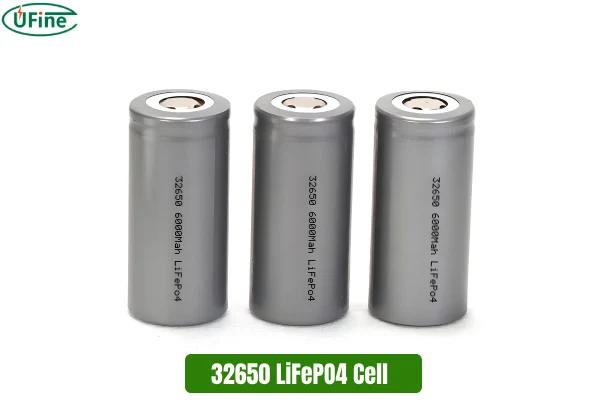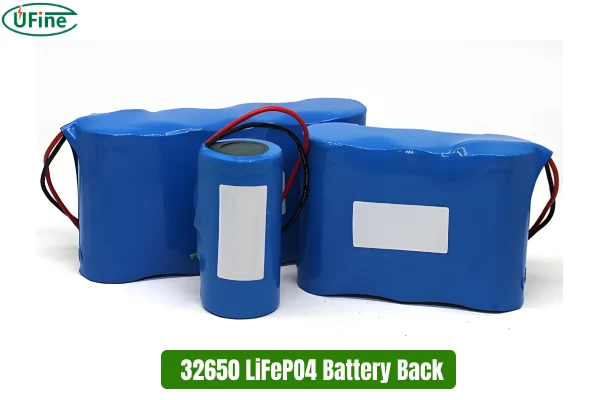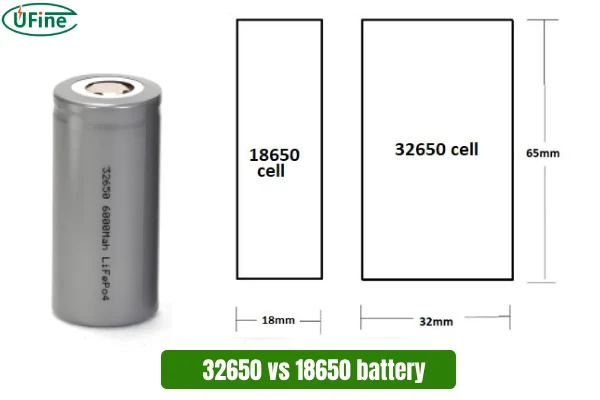In the realm of energy storage, the 32650 LiFePO4 battery stands out for its exceptional performance, reliability, and safety. Whether you’re exploring renewable energy solutions, electric vehicles, or high-demand portable electronics, understanding this battery type is crucial. This article will provide an in-depth look at the 32650 LiFePO4 battery, covering its specifications, advantages, applications, and how it stacks up against the popular 18650 battery. We’ll also delve into the pricing factors and highlight a leading manufacturer, Ufine Battery.
Part 1. What is 32650 LiFePO4 battery?
The 32650 LiFePO4 battery is a lithium iron phosphate battery that measures 32mm in diameter and 65mm in length, hence the name “32650.” This type of battery is known for its superior safety, long cycle life, and stable performance compared to other lithium-ion batteries. The LiFePO4 chemistry offers a significant improvement in thermal stability and safety, making it less prone to overheating and combustion.
Key Features:
- Chemical Stability: The LiFePO4 chemistry provides a stable and safe battery solution, with lower risk of thermal runaway.
- Durability: Known for its long cycle life, the 32650 LiFePO4 battery can endure thousands of charge and discharge cycles.
- High Power Output: Capable of delivering high current, making it suitable for high-drain applications.
- Environmental Impact: Less toxic and more environmentally friendly compared to other lithium-ion batteries.
Part 2. 32650 LiFePO4 cell parameters
Understanding the technical parameters of the 32650 LiFePO4 cell is essential for determining its suitability for various applications. Below are the detailed specifications:
- Diameter: 32mm
- Length: 65mm
- Nominal Voltage: 3.2V
- Capacity: Typically ranges from 5000mAh to 6500mAh, depending on the manufacturer and specific model.
- Discharge Rate: Often between 1C to 3C, which translates to delivering 100% of the battery’s capacity in one to three hours.
- Cycle Life: Over 2000 cycles, indicating the number of times the battery can be fully charged and discharged before its capacity falls below 80% of its original value.
- Operating Temperature Range: -20°C to 60°C, highlighting the battery’s ability to function in various environmental conditions.
These parameters highlight the battery’s robustness and make it an excellent choice for high-demand applications requiring reliable and long-lasting power.
Part 3. 32650 LiFePO4 battery advantages and disadvantages
When choosing a battery, it’s crucial to weigh its advantages and disadvantages. The 32650 LiFePO4 battery offers numerous benefits, but it also has some drawbacks.
Advantages:
- Long Lifespan: Capable of over 2000 charge cycles, significantly outlasting many other battery types.
- Safety: LiFePO4 chemistry reduces the risk of thermal runaway, fires, and explosions.
- High Discharge Rate: Provides a consistent and powerful energy output, suitable for high-drain applications.
- Environmental Friendliness: Contains less toxic materials and is more environmentally friendly than other lithium-ion batteries.
- Thermal Stability: Performs well under a wide range of temperatures, making it suitable for various environments.
- Low Self-Discharge Rate: Retains charge well over time, with minimal energy loss when not in use.
Disadvantages:
- Size and Weight: Larger and heavier than other battery types, such as the 18650, which can be a drawback for portable applications.
- Cost: Generally more expensive due to the advanced materials and manufacturing processes involved.
- Lower Energy Density: Has a lower energy density compared to some other lithium-ion batteries, meaning it stores less energy per unit of weight.
Part 4. What is the voltage of 32650 LiFePO4 cell?

The nominal voltage of a 32650 LiFePO4 cell is 3.2V. This stable voltage provides a reliable power output, which is crucial for applications that demand consistent performance. Additionally, the voltage remains relatively steady throughout the discharge cycle, contributing to the battery’s reliability and efficiency.
Where is 32650 LiFePO4 Battery Used?
The versatility of the 32650 LiFePO4 battery allows it to be used in a wide range of applications. Here are some common uses:
- Electric Vehicles (EVs): Powers electric cars, scooters, bikes, and other electric transport vehicles due to its high power output and long cycle life.
- Solar Energy Storage: Stores energy generated from solar panels, ensuring a steady supply of electricity even when the sun isn’t shining.
- Portable Electronics: Used in devices like flashlights, radios, and other gadgets that require a reliable power source.
- Medical Devices: Provides a safe and dependable power source for critical medical equipment.
- Industrial Applications: Powers tools and machinery, offering a robust and durable energy solution for industrial use.
- Backup Power Systems: Serves as a reliable backup power source for homes, businesses, and critical infrastructure during power outages.
Part 5. 32650 LiFePO4 battery vs 18650 battery
Comparing the 32650 LiFePO4 battery to the 18650 battery helps in understanding their respective strengths and weaknesses across various metrics:
-
Size:
- 32650: 32mm diameter, 65mm length
- 18650: 18mm diameter, 65mm length
-
Capacity:
- 32650: Typically 5000mAh to 6500mAh
- 18650: Typically 2000mAh to 3500mAh
-
Voltage:
- 32650: 3.2V (LiFePO4)
- 18650: 3.7V (Li-ion)
-
Cycle Life:
- 32650: Over 2000 cycles
- 18650: Around 500-1000 cycles
-
Discharge Rate:
- 32650: 1C to 3C
- 18650: 0.5C to 2C
-
Weight:
- 32650: Heavier
- 18650: Lighter
-
Applications:
- 32650: Ideal for high-capacity, high-power applications like EVs and solar storage
- 18650: Commonly used in portable electronics and smaller devices
Part 6. LiFePO4 32650 battery price
The price of LiFePO4 32650 batteries can vary based on several factors, including capacity, brand, and quantity purchased. Here’s a breakdown of what affects the prices:
- Capacity: Higher capacity cells generally cost more due to the increased amount of active material.
- Brand: Well-known brands with a reputation for quality may charge a premium.
- Quantity: Buying in bulk can significantly reduce the per-unit cost.
- Market Demand: Prices can fluctuate based on supply and demand dynamics in the market.
On average, a single 32650 LiFePO4 battery costs between $10 to $20. However, prices can go higher for specialized or high-capacity versions.
Part 7. LiFePO4 32650 battery manufacturer
One of the prominent manufacturers of 32650 LiFePO4 batteries is Ufine Battery. Based in China, Ufine Battery specializes in customizing lithium batteries, including lithium polymer batteries, cylindrical batteries, 18650 batteries, and LiFePO4 batteries with different capacities, sizes, voltages, and shapes. Known for their quality and innovation, Ufine Battery is a reliable choice for those needing tailored battery solutions for various applications.
The 32650 LiFePO4 battery is a robust and versatile energy storage solution. With its impressive parameters, numerous advantages, and wide range of applications, it stands out as a top choice for high-demand uses. By understanding its specifications, benefits, and market positioning, you can make informed decisions to meet your energy needs effectively.
Related Tags:
More Articles

How High-Quality Lithium Battery Cells Are Made: A Comprehensive Guide
High-quality lithium battery cells stand out for their performance, reliability, and safety. Learn what sets them apart in materials, manufacturing, and testing
Comparing Mechanical Batteries and Lithium Batteries: Which Is Right for Your Application?
Explore the differences, advantages, and limitations of mechanical and lithium-ion batteries to find the best solution for your needs.
Exploring EV Battery Safety
Is your EV battery safe? Explore how EV battery safety works. Understand the role of battery cells and safety layers to protect your vehicle. Read more now!
What Type of Battery is Blade Battery? Unveiling Its True Features
Discover the key features of BYD's Blade Battery. Learn how it stands out in the market. Click to uncover its unique benefits now.
How Much Copper Goes into a Lithium-Ion Battery?
Copper is essential in lithium-ion batteries, powering devices from smartphones to EVs. How much copper is used? Let's explore the details.





